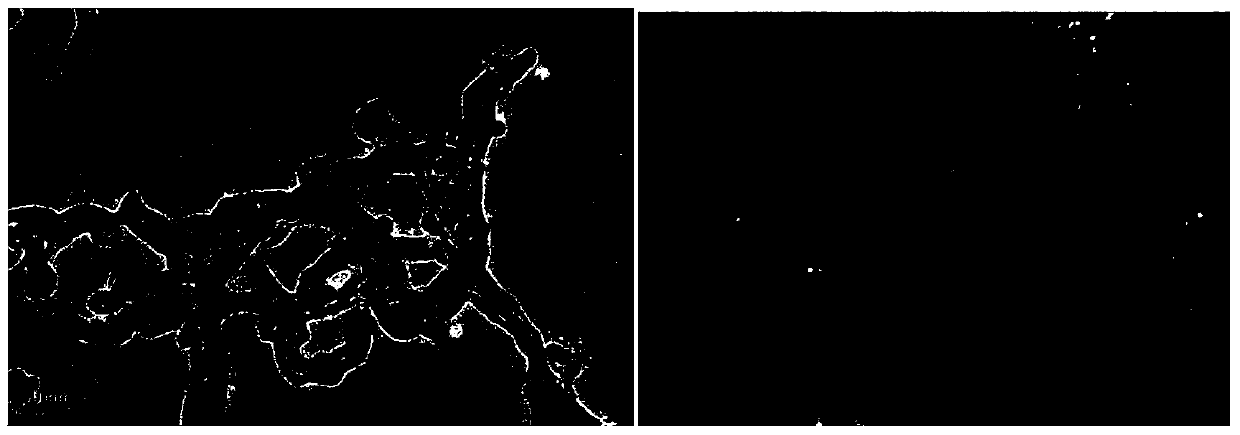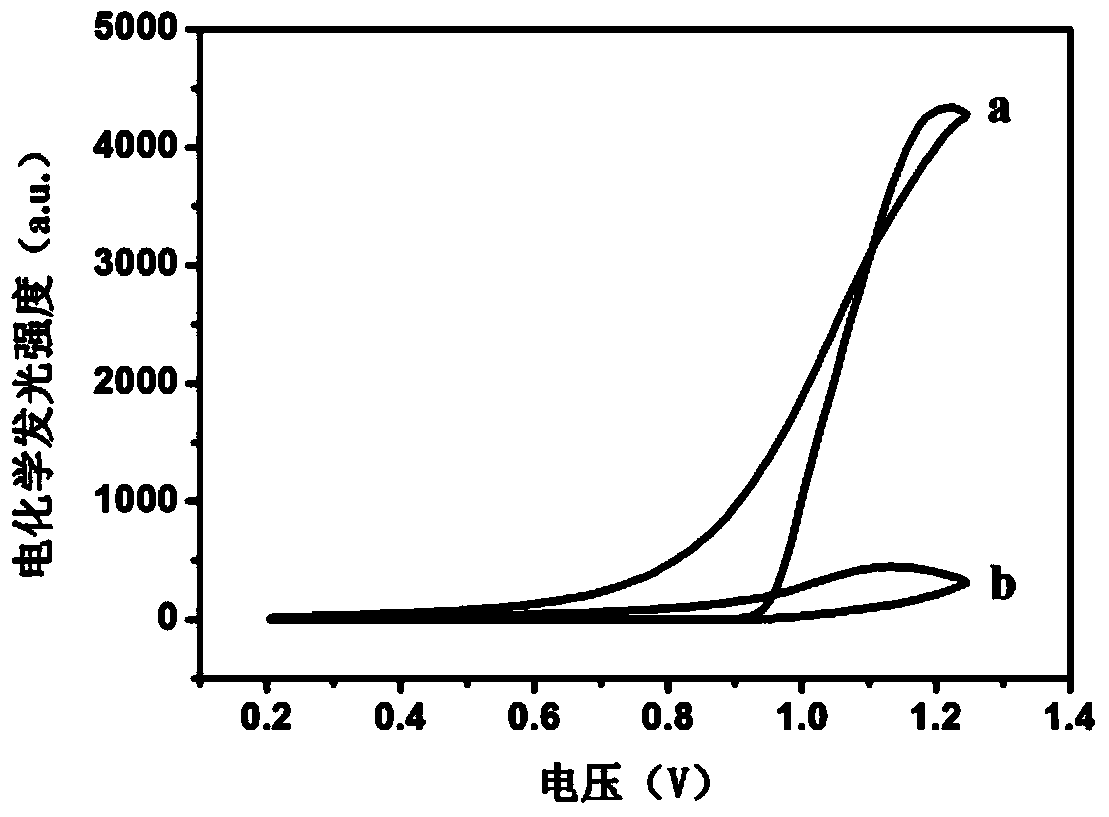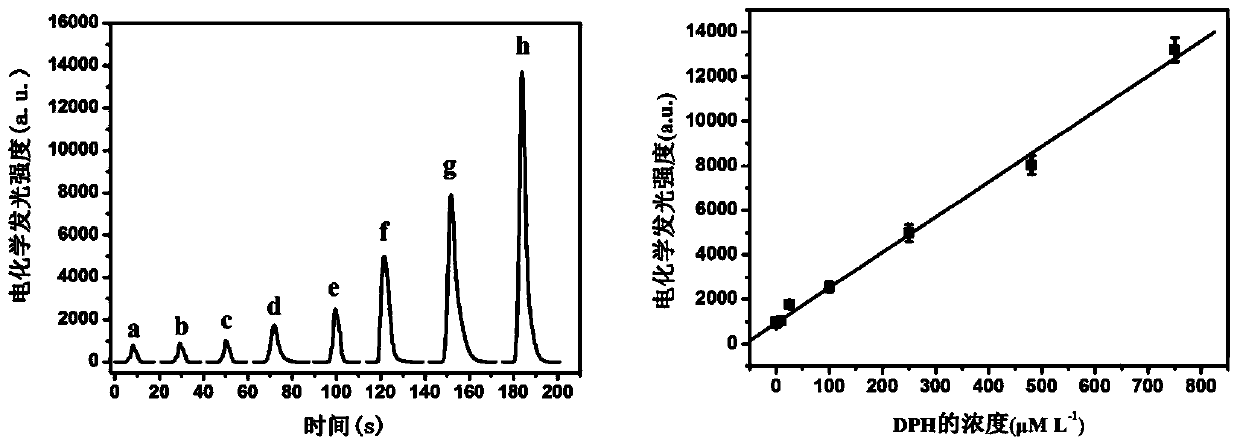Electrochemical-luminescence sensor for quickly detecting diphenhydramine hydrochloride by high sensitivity and preparation method thereof
A diphenhydramine hydrochloride, sensitive detection technology, applied in the direction of chemiluminescence/bioluminescence, electrochemical variables of materials, analysis by making materials undergo chemical reactions, etc., can solve the problem of difficult time and space control, chemiluminescence Difficult to reuse reagents, uneven mixing of solutions, etc., to achieve good electrochemical performance and biocompatibility, reasonable detection recovery, and good electrical conductivity
- Summary
- Abstract
- Description
- Claims
- Application Information
AI Technical Summary
Problems solved by technology
Method used
Image
Examples
Embodiment 1
[0026] Example 1: Ru(bpy) 3 2+ Preparation of / MWCNT-Cys-AuNPs / Nafion Modified Electrode
[0027] Weigh 30mg of multi-walled carbon nanotubes into 60mL H 2 SO 4 / HNO 3(3:1) mixed acid was continuously ultrasonicated for 16h, then centrifuged and washed until the pH value was close to 7, and dried in an oven at 60°C. Take 15 mg of the above interrupted carbon nanotubes and dissolve them in 5 mL of water, then add 20 mg of 1-ethyl-(3-dimethylaminopropyl) carbodiimide hydrochloride (EDC·HCl), 20 mg of N-hydroxy Succinimide (NHS) and 40 mg of cysteine (L-cystine) were shaken uniformly by ultrasound, adjusted to a pH between 7 and 8 with 0.1 mol NaOH, shaken overnight to form MWCNT-Cys complexes, centrifuged, washed and dry. Get 100mL of 0.01% chloroauric acid solution and heat it in an Erlenmeyer flask. After the solution boils, add 2mL trisodium citrate (0.02g / mL) solution quickly and continue to boil for 15 minutes. After natural cooling, the gold nanoparticle solution i...
Embodiment 2
[0029] Example 2: Ru(bpy) 3 2+ Qualitative detection of electrochemiluminescence of DPH by / MWCNT-Cys-AuNPs / Nafion modified electrode
[0030] Ru(bpy) 3 2+ / MWCNT-Cys-AuNPs / Nafion modified electrode is placed in 4mL0.1MPBS (pH=7.4) buffer solution, the redox current generated is very small and the light intensity is relatively weak, which is a Ru(bpy) 3 2+ Since the electrochemiluminescence process of annihilation, after adding 0.25mM DPH, the intensity of electrochemiluminescence is obviously enhanced, showing a typical co-reactant electrochemiluminescence process ( figure 2 ), and the modified electrode exhibited good electrochemiluminescent properties for DPH.
Embodiment 3
[0031] Example 3: Ru(bpy) 3 2+ Quantitative detection of electrochemiluminescence of DPH by / MWCNT-Cys-AuNPs / Nafion modified electrode
[0032] Ru(bpy) 3 2+ / MWCNT-Cys-AuNPs / Nafion modified electrode placed in PBS (pH=9.0) buffer solution containing a certain amount of DPH, with the continuous addition of DPH, the intensity of electrochemiluminescence increases continuously, when DPH reaches a certain concentration, the light intensity There is no longer a noticeable increase. The linear range of the sensor to detect DPH is 2×10 by plotting the concentration of DPH with the intensity of electrochemiluminescence. -8 M~7.5×10 -4 M, the detection limit is 6.7nM (S / N=3) ( image 3 ). It was placed in PBS (pH=9.0) containing different concentrations of DPH, showing better stability ( Figure 4 ), the experimental results show that the prepared sensor has the advantages of low detection limit, high sensitivity, wide linear range, and stability.
PUM
 Login to View More
Login to View More Abstract
Description
Claims
Application Information
 Login to View More
Login to View More - R&D
- Intellectual Property
- Life Sciences
- Materials
- Tech Scout
- Unparalleled Data Quality
- Higher Quality Content
- 60% Fewer Hallucinations
Browse by: Latest US Patents, China's latest patents, Technical Efficacy Thesaurus, Application Domain, Technology Topic, Popular Technical Reports.
© 2025 PatSnap. All rights reserved.Legal|Privacy policy|Modern Slavery Act Transparency Statement|Sitemap|About US| Contact US: help@patsnap.com



